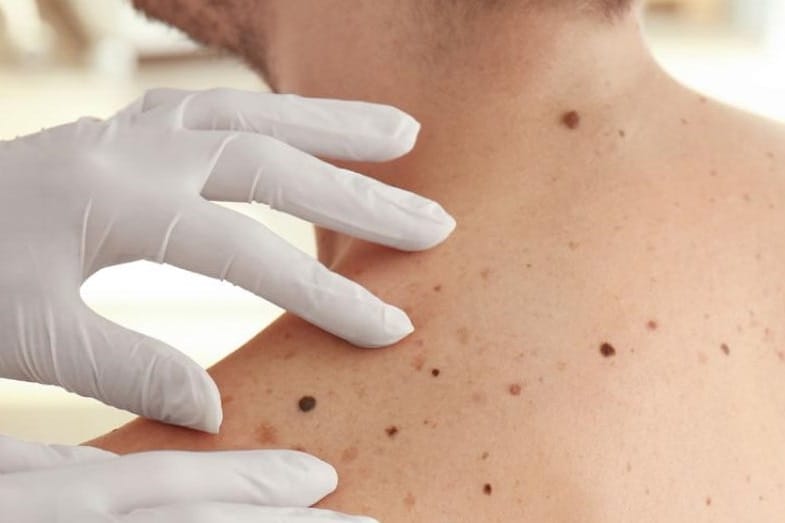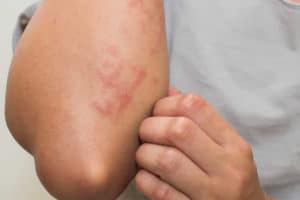Do you have an annoying mole on your face or other parts of your body that you want to remove? You may have heard of freezing moles. Can you freeze off a mole? If so, how long does it take to fall off? In this post, I’m going to address these questions. By the end of the article, you will know all about how a mole is removed and how long it takes for it to fall off.
Can you freeze off a mole? Yes, you can freeze off a mole. The method for freezing a mole is called cryotherapy or cryosurgery. Doctors use super-cold nitrogen in the form of liquid to freeze off moles or skin tags and get rid of them.
If you freeze a mole, how long for the mole to fall off? After freezing the mole, the mole usually falls off within 10 to 14 days. The time it takes for a mole to fall off also depends on the condition of the mole before treatment.
Your doctor will have to ensure that the mole or skin growth is not infected or malignant because special precautions have to be observed in these particular cases.
Read on to learn more about freezing off a mole and how long it takes for the mole to fall off.
Can You Freeze Off a Mole? How Long Does It Take to Fall Off?
Moles grow as a result of the clumping of melanocytes on the skin surface. Melanocytes are cells that are responsible for the color of your skin. Exposure to the sun’s UV rays can darken the skin.
There are atypical moles that could increase your risk for skin cancer or melanoma. The dysplastic nevi can be differentiated from normal moles because of its irregular microscopic features. You have to watch out for these types of moles, as they can quickly progress to skin cancer.
Thus, you should not pick or try to remove your mole without your doctor’s knowledge. It could cause serious problems that could be fatal to your health.
How to Freeze Moles
A mole or skin tag can be frozen off using cryotherapy or cryosurgery. This process uses super-cold liquid nitrogen (-350 degrees Celsius) to freeze off the mole until it falls off. Direct application of nitrogen to the mole will cause the cells or tissues to freeze, dry up, and eventually fall off.
When cryotherapy is recommended to get rid of your mole, a healthcare assistant will prepare you for the procedure. The skin area where your mole is located is then sterilized and appropriately prepared for the procedure. The mole is then sprayed with cold liquid nitrogen from a canister. Liquid nitrogen could also be applied using a sterile cotton swab directly into the mole.
What Is Cryotherapy or Cryosurgery?
Aside from removing moles, cryotherapy is also used to remove warts and other skin growths, such as actinic keratosis and seborrheic keratosis. When the mole or wart is too big, two or more cryotherapy sessions may be needed.
This procedure can also be used to remove cancerous growths and abnormal cells in the body. It’s used for aesthetic purposes as well, such as the removal of freckles. However, a doctor who specializes in these areas should perform this delicate procedure.
Is Freezing a Mole Painful?
During treatment, you can feel a little sting or itch when your skin comes in contact with liquid nitrogen. Don’t worry because these sensations are tolerable. In fact, anesthesia is not given during the procedure.
This procedure is considered painless compared to other mole removal treatments. The period of recovery is quite fast as well, provided that there are no complications.
What to Expect After Freezing Moles

Right after treatment, you would notice a small blister in the mole area. It could be swollen or may feel sore and tender. However, these symptoms are bearable.
After 1 Day
After a day, the blister and soreness would start to subside. When going out, you may want to apply a band-aid to prevent developing an infection from external sources.
After 7 Days
After a week (7 days), a red or brown scab would cover the mole area. There’s no need to worry as scab formation is normal after mole removal. Just wait for it to fall off. As mentioned earlier, it takes about 10 days at most for a mole to fall off after cryotherapy freezing.
When taking a bath, wash the area with mild soap and water. Gently dry the affected area by patting it with a soft cloth. Doing so will help loosen up the scab without forcibly removing it.
After 1 Month
When the skin heals, the scab will fall off by itself, usually within four weeks. Under normal circumstances, your skin would assume its normal color when the crust is gone. The doctor may prescribe topical creams to prevent scarring. Don’t use any medication without your doctor’s advice to avoid dangerous side effects.
If you have used Vaseline before and you don’t have allergies to it, you can use it safely as a coating when the area develops a crust. It’s hypoallergenic and has no toxic ingredients. It can also prevent dryness of the affected skin area.
In case the blister gets infected or becomes raw and inflamed, you have to consult your doctor ASAP. These symptoms may indicate an infection, which requires immediate medical treatment.
Dos and Don’ts After Freezing the Mole
- Observe personal hygiene. Infection would set in when your body and surroundings are dirty.
- Follow your doctor’s orders, especially your home medication and routine.
- Don’t swim and do water activities for a week, unless allowed by your doctor.
- Don’t apply makeup until the skin area is healed.
- Don’t apply glycolic acids, tretinoin, and similar preparations until the skin area is healed.
- Don’t submerge your skin in water for long periods or expose it for a long time under the sun. Unnecessary exposure could irritate the mole area.
How to Freeze a Mole Off at Home
You may be thinking of freezing off your mole at home, as it would be more convenient and less expensive. Some DIY products claim that they can effectively freeze off moles in the convenience of your home.
Well, it may seem practical, but before you decide to use DIY products, learn more facts about the procedure.
DIY Freeze Off Method: Butane Spray
Butane is a freezing agent used in most DIY home sprays instead of liquid nitrogen. Although butane’s coldest temperature is about 100 degrees Celcius below zero, it isn’t applied directly to the mole as people tend to spray a few inches from the spot. For this reason, only around 50% reach the target area.
Mole penetration is not as deep as the liquid nitrogen applied by doctors, which is 350 degrees Celcius below zero. Therefore, DIY sprays are not as effective as the substance used by skin specialists. A doctor or dermatologist has the expertise, appropriate training, proper equipment, and effective method to freeze off your mole.
Rest assured that in your doctor’s hands, there would be no harmful side effects. The mole would also come off correctly and more quickly without complications. The sterilization process of the procedure would also be 100% sure than doing it at home.
The DIY freeze spray may be cheaper at the start, but when complications occur, you would be spending more on doctor’s fees. Moreover, freezing off your mole at home might put your health at risk, as not all products are a hundred percent safe to use. It would take longer for the product to take effect as well, so you’ll be spending more to purchase it again. If done right, you could be successful in freezing moles without any side effects.
Steps in Freezing Off Your Mole at Home

Step #1 – Clean and sterilize the mole area thoroughly by starting from the center moving outward in circles.
Step #2 – Wear disposable and sterile gloves. All your equipment should also be properly sterilized. Apply the solution as indicated with sterile cotton or applicator stick.
Step #3 – If the solution is a spray, spray it directly to the mole or the roots of the mole.
Step #4 – If the mole is small, you can get rid of it in one sitting. But if the mole is big, you may have to do it in several sessions.
Step #5 – Finish the procedure and clean your working area. You can place a sterile band-aid over the mole area for protection.
Tips on Freezing Off Moles
- Examine the mole first to determine how much substance you’ll need.
- Don’t freeze off a big mole in one session. Big moles need more than one treatment to freeze off.
- Sterilize the mole area using iodine or 70% isopropyl alcohol before starting the procedure.
- You must observe strict aseptic methods by using sterile gloves and cotton.
- Don’t cut off, trim, or shave a mole, as it will spread and could get contaminated and infected.
- Moles tend to spread, so you must remove moles from their roots to prevent another growth.
- If you’re having your moles frozen off in a clinic, remember to ask your doctor about your home medications. It’s essential to follow proper post-treatment care.
Advantages and Disadvantages of Freezing Off Moles at Home
Freezing off moles at home has some advantages and disadvantages.
Advantages
- You don’t have to spend extra time, energy, and money to get your treatment.
- You can do the procedure in the comfort of your own home.
Disadvantages
- The mole area could bleed, and you may not have the emergency equipment to deal with it.
- The procedure can be tricky, and serious complications could occur without a specialist.
- The freezing agent used may not be as effective as what doctors use.
- You may not know if a mole is cancerous or not, so you can be careless during its removal. Improper mole removal may stimulate cancer cells to spread and could quickly become life-threatening.
- Proper aseptic methods may not be observed, which increases the risk of infecting the mole and the area surrounding it.
- Creams sold online may increase the risk of thick scarring, leading to permanent scars.
As you can see, there are more disadvantages than advantages when freezing off moles at home. Hence, it’s recommended that you choose the safest and most effective technique to freeze off a mole by having a competent doctor perform the procedure.
Conclusion – Can You Freeze Off a Mole? How Long Does It Take to Fall Off?
So to answer the questions: Can you freeze off a mole? How long does it take to fall off? The answer is yes. You can freeze off a mole with the use of super-cold liquid nitrogen performed by a licensed doctor, dermatologist, or skin specialist. The mole can fall off after one or more sessions, depending on its size. At most, the whole treatment process could take 10 to 14 days for the mole to fall off.
As for home treatment methods, they could be dangerous if done incorrectly. Don’t risk your health for chump change. Your health is your wealth, so treasure it as it’s priceless. Stay safe and healthy by using safe and effective methods to freeze off your mole.




